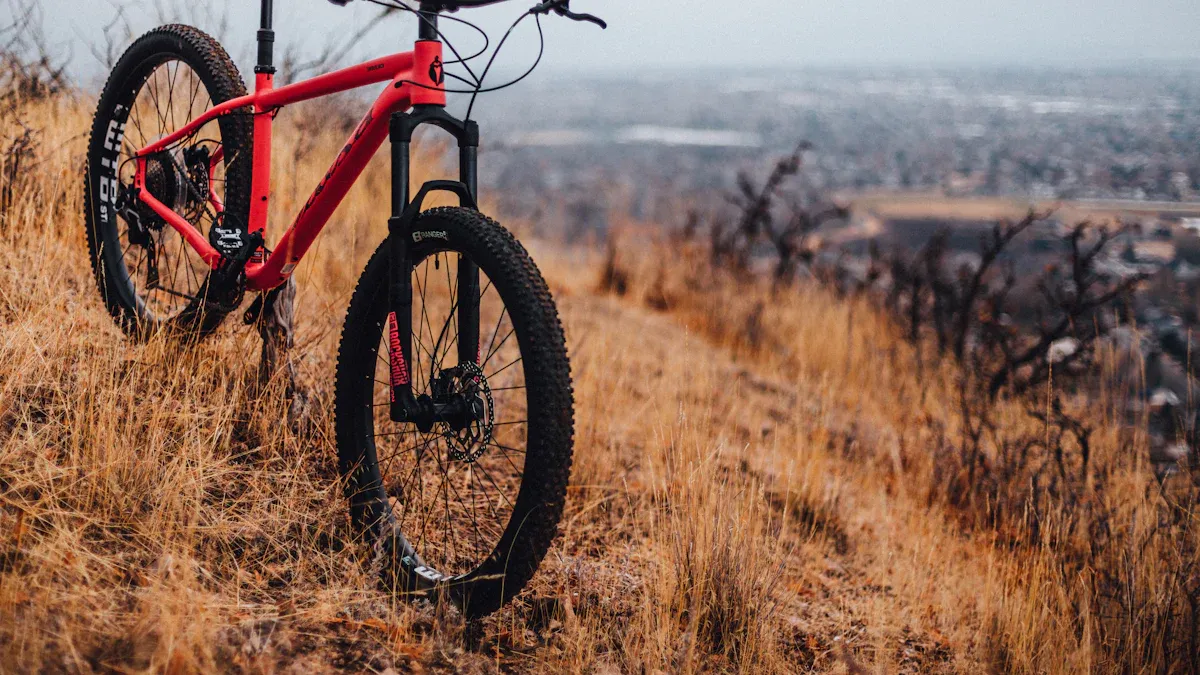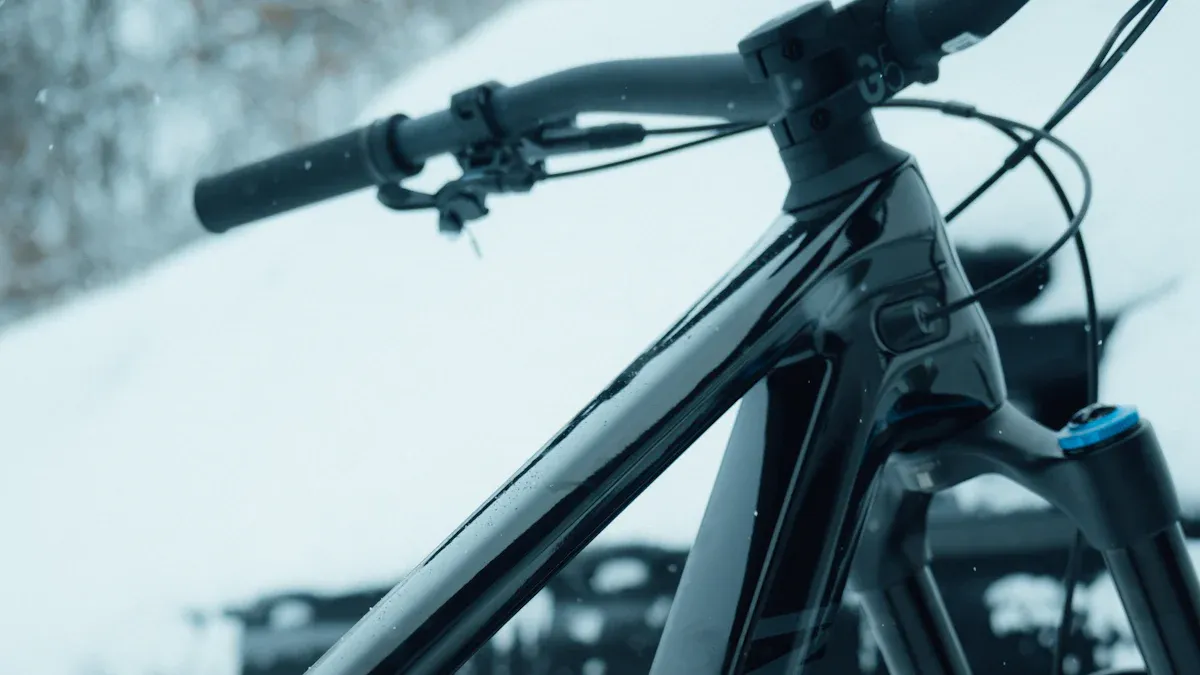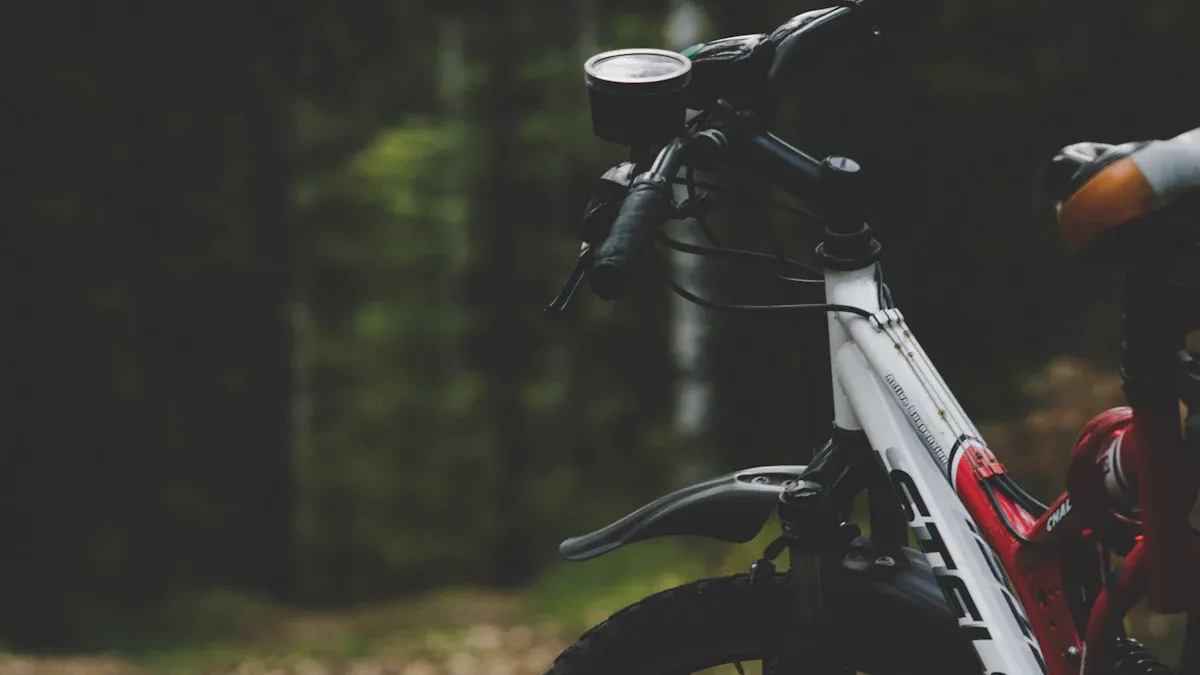
Choosing the right hardtail mountain bike frames is very important for your ride. Every rider has different preferences and trails that influence their choice. Hardtail mountain bike frames work well on smooth paths and steep hills. They climb better, cost less, and require less maintenance than full-suspension bikes. This simple design helps you focus on improving your skills and riding better. With hardtail mountain bike frames, you get lightweight builds that make handling easier and enhance your ride. Whether you are a beginner or an experienced rider, understanding what to consider in hardtail mountain bike frames can help you find the best fit.
Key Takeaways
Pick your hardtail mountain bike frame based on the trails you ride and how you ride for the best fun.
Aluminum frames are a good mix of cost, strength, and weight. They are great for most riders.
Carbon fiber frames are light and strong. They are perfect for serious riders who want the best performance, but they cost more.
The shape of the frame, like the head tube and seat tube angles, changes how your bike rides and feels on different trails.
Choosing the right bike size by measuring your height and inseam makes riding more comfortable, gives you better control, and keeps you safe on the trail.
Frame Materials

The material you pick for hardtail mountain bike frames is very important for how you ride. Each material has its own pros and cons. These affect weight, strength, and price. Let’s look at the three most common materials for hardtail frames: aluminum, carbon fiber, and steel.
Aluminum Frames
Aluminum frames are the most popular choice for hardtail mountain bikes. They make up 62.1% of the global mountain bike frame market. Here’s why:
Pros:
Cost-Effective: Aluminum frames usually cost less than carbon fiber. This makes them a good choice for riders on a budget.
Durability: Modern aluminum frames last a long time. They have low failure rates when used normally. They can handle rough trails and tough hits.
Lightweight: They are not as light as carbon fiber, but aluminum frames are still light, usually around 4.6 kg.
Cons:
Fatigue Limit: Aluminum does not have a true fatigue limit. This means it can fail after repeated stress. But with good design and larger tube sizes, manufacturers reduce this risk.
Aluminum frames are popular for their low cost and strength. They are a great choice for casual riders. Models like the WEIZE Hardtail Mountain Bike and HILAND MTB show the best value in carbon hardtail options today.
Carbon Fiber Frames
Carbon fiber frames are becoming more popular, especially for serious riders. Here’s what you should know:
Pros:
Lightweight: Carbon fiber frames are the lightest, averaging around 3.8 kg. This makes them great for climbing and racing.
Strength and Stiffness: They have a great strength-to-weight ratio. This helps with power transfer and absorbs shocks for a smoother ride.
Corrosion Resistance: Carbon fiber does not rust like metal frames. This can help your bike last longer.
Cons:
Cost: Carbon fiber frames usually cost more because they are harder to make. They can be a big investment for serious riders.
Brittleness: Carbon fiber is strong but can be more fragile than aluminum or steel. It can get damaged from hard hits.
With an average lifespan of 6 to 10 years with normal use, carbon fiber frames are a good choice for those wanting performance and durability.
Steel Frames
Steel frames have been around for a long time in biking. They are known for their strength and durability. Here’s how they compare:
Pros:
Durability: Steel frames are very strong and can take a lot of abuse. They are less likely to dent or scratch compared to aluminum.
Ride Comfort: Steel naturally dampens vibrations, which can make rides more comfortable on rough paths.
Cons:
Weight: Steel frames are usually heavier than aluminum and carbon fiber. This can be a downside for riders focused on performance.
Cost: Some steel frames can be cheap, but high-end ones can be expensive, often similar to aluminum.
Here’s a quick comparison of the average weights of these materials:
Frame Material | Average Weight Comparison | Example Weight (with shock) |
|---|---|---|
Carbon Fiber | Lightest | ~3.8 kg |
Aluminum | Heavier than carbon | |
Steel | Heavier than carbon | N/A |
Frame Geometry
For hardtail mountain bikes, frame geometry is very important. It affects how your bike rides on different surfaces. The angles and lengths of the frame parts can change your riding experience a lot. Let’s look at the main geometry points that impact performance.
Head Tube Angle
The head tube angle is key for how your bike steers. Here’s how it works:
Steeper Angles (71 degrees): These angles help with quick steering. They are great for cross-country rides and tight turns.
Slacker Angles (67 degrees): These angles give more stability at high speeds. They are best for all-mountain and downhill biking. Slacker angles push the front wheel out, making steering feel less quick but more steady.
Trail Influence: The head tube angle works with fork offset to set the bike’s trail. This affects how stable or quick your ride feels. More trail makes the bike self-center, while less trail means quicker steering.
Seat Tube Angle
The seat tube angle changes your position on the bike. It can also affect how well you ride. Here’s what to know:
Steeper Angles: These angles push you forward over the cranks. This helps with power transfer and traction, especially when climbing. But if the angle is too steep, it can make shifting your weight hard and uncomfortable.
Balance: Finding the right seat tube angle is key for comfort and performance. A good angle helps you pedal efficiently without losing maneuverability.
Top Tube Length
Top tube length is another important factor for your fit and comfort on the bike:
Fit Matters: The length affects how high you stand over the bike and the overall frame size. An incorrect top tube length can cause discomfort and less control, hurting your performance.
Women’s and Kids’ Bikes: These bikes often have shorter top tubes. This helps fit different body shapes and gives a more comfortable riding position.
Sizing Your Hardtail Mountain Bike
Getting the right size for your hardtail mountain bike is very important for comfort and performance. A bike that fits well makes your ride better. It helps you ride trails with more confidence. Here’s a simple guide to help you find the best fit.
Measuring Your Height
Start by measuring your height. Here’s how to do it:
Put a large book or notebook between your legs, spine up, like a saddle.
Mark the wall at the top of the book’s spine.
Measure from the mark to the floor to find your inseam length.
Do the measurement again to make sure it’s right.
This inseam measurement helps check standover clearance. This is important for a safe and comfy bike fit. While your height is a good start, measuring your inseam makes sure you have the right standover height. This helps you get on and off the bike easily.
Inseam Measurement
Inseam measurement is very important for picking the right hardtail frame size. A longer inseam usually needs a taller stack and a shorter reach. Riders with long legs often have shorter torsos, which changes what bike geometry they need. For example, a 17″ frame with 29″ wheels may give a shorter reach and more stability. This makes it good for those with longer inseams. Having about 2 inches (5 cm) of standover clearance is key for comfort and safety.
Reach and Stack
Reach and stack measurements are important for finding the right fit. Reach is the horizontal distance from the bottom bracket to the top of the headtube. Stack is the vertical distance. These measurements help you compare different hardtail frames well. They relate to your riding position and comfort, which is very important for different mountain biking styles.
Experts say that sizing depends on many geometric measurements, not just one size. Things like head tube angle, chainstay length, and bottom bracket height also affect your fit. It’s a good idea to test ride different sizes to fit brand differences and personal likes.
Terrain Considerations

When you pick a hardtail mountain bike, the type of ground you will ride on is very important. Different surfaces need special features from your bike’s frame material and shape. Let’s see how different terrains affect your choice.
Cross-Country Riding
For cross-country (XC) riding, you want a bike that is light and works well. This kind of terrain usually has flat or rolling trails. Here’s what to look for:
Frame Material: Aluminum or carbon fiber frames are best. They help you pedal faster and more efficiently.
Geometry: Look for a head tube angle between 68-71 degrees. This angle helps with quick steering, which is great for tight turns and keeping speed on smooth paths.
Frame Material | Weight | Strength | Typical Terrain Use |
|---|---|---|---|
Aluminum | Light | High | Flat/rolling trails needing speed and efficiency |
Carbon Fiber | Very Light | High | Performance on smooth terrain needing stiffness and lightness |
Some great hardtail mountain bikes for XC riding are the Canyon Lux and the Trek Procaliber Gen 3 Carbon. These bikes are known for being lightweight and climbing well.
Trail Riding
Trail riding has many challenges, like roots, rocks, and steep climbs. You need a bike that can handle these while still being fun. Here’s what to think about:
Frame Features:
An aluminum frame is strong and durable without costing too much.
A carbon fiber frame is very light and strong, making your ride better.
A suspension fork with about 120mm of travel helps absorb bumps, making it more comfortable and easier to control.
Frame Feature | Benefit for Trail Riding on Hardtail MTB |
|---|---|
Aluminum Frame | Strong, lightweight, affordable; offers great value and durability for trail conditions. |
Carbon Fiber Frame | Tunable stiffness and flexibility, very light, high strength-to-weight ratio, improves ride feel and performance. |
Dropper Seatpost | Allows quick seat height changes for better handling on steep descents and tricky lines, important for trail riding. |
Models like the Specialized Epic EVO and Commencal Meta HT are great for trail riding. They have shapes that improve control and stability on tough ground.
Technical Terrain
When you ride on rocky or technical terrain, you need a hardtail that can take hits and stay stable. Here’s what to remember:
Frame Material: Steel or titanium frames are great choices. They are strong enough for rough trails and help reduce vibrations.
Geometry: A slacker head tube angle gives more stability, which is important for steep descents or rocky paths.
Frame Material | Weight | Strength | Comfort | Typical Terrain Use |
|---|---|---|---|---|
Steel | Heavy | Very High | High | Rocky/technical terrain needing durability and comfort |
Titanium | Moderate | Very High | High | Steep climbs/descents and rough terrain needing strength and comfort |
For technical terrain, look at models like the Moots MXC or the Sage Powerline V3 Titanium. These bikes are made to handle tough trails while keeping your ride comfortable.
Best Hardtail Mountain Bikes
When you want to find the best hardtail mountain bikes, there are great choices. Let’s look at three top models that give you amazing value and performance for different riding styles.
Model A Overview
The Leoguar Fastron SO is a special hardtail that mixes classic mountain bike features with new technology. Here’s a quick look at its specs compared to other popular models:
Feature | Leoguar Fastron SO | Specialized Fuse Comp 29 | Ragley Marley 2.0 | Canyon Stoic 4 |
|---|---|---|---|---|
Frame | 6061 Aluminum Alloy | A1 Premium Aluminum | 6061 Alloy | 6061-T6 Aluminum |
Fork Travel | 100mm | 130mm Air Fork | 130mm | 140mm |
Drivetrain | Mechanical 7-speed | SRAM SX Eagle 1×12 | Shimano Deore 1×10 | Shimano SLX/Deore 1×12 |
Brakes | Tektro Hydraulic Disc (180mm) | SRAM Level Hydraulic Disc | Shimano M4100 Hydraulic Disc | SRAM Guide T (4-piston) |
Tires | Fat 26×4.0″ | Standard MTB tires | Standard MTB tires | Standard MTB tires |
Motor | 750W electric motor | None | None | None |
Price | ~$1,799 | ~$2,000 | ~$1,400 | ~$1,999 |
The Leoguar Fastron SO is special because of its electric assist and fat tires. This makes it great for tough trails. It’s a good choice if you want a bike that can handle many terrains while giving you a boost when needed.
Model B Overview
Next is the Kona Mahuna, a hardtail that performs well without costing too much. Here are its main specifications:
Specification | Details |
|---|---|
Frame Material | Kona Race Light 6061 Aluminum Butted |
Suspension Fork | RockShox Judy Silver TK Solo Air, 100mm travel |
Wheels | WTB ST i27 TCS 2.0 rims |
Tires | Maxxis Forekaster 27.5×2.35″ front and rear |
Drivetrain | Shimano Deore 11-speed, FSA Alpha Drive 1x crankset, 28t chainring |
Brakes | Shimano MT201 Hydraulic with 180mm front and 160mm rear rotors |
Seat Post | Kona Thumb 31.6mm |
Cockpit | Kona XC/BC Riser Bar and Stem with Kona Key Grip slip on |
Price | $1,049 USD |
The Kona Mahuna has a strong build and reliable parts. This makes it a great option for those who want quality without spending too much.
Model C Overview
Finally, check out the Trek Roscoe 7. This bike is known for being versatile and comfortable on many trails. Here’s what makes it special:
Frame: Aluminum frame that balances weight and strength.
Suspension: 140mm front suspension travel for smooth rides over bumpy terrain.
Tires: 2.6-inch tires give great traction and stability.
Price: About $1,299, making it a budget-friendly choice without losing quality.
The Trek Roscoe 7 is great for climbing and offers a comfy ride on singletrack and bikepacking trips.
Choosing the right hardtail mountain bike frame is important. First, think about the trails you want to ride. This choice changes the bike’s shape and features. Next, pick between a hardtail and a full-suspension bike. Hardtails are often better for cross-country riding because they transfer power well.
Also, think about the frame material. Carbon fiber is strong and light but costs more. Aluminum is cheaper and a good option for many riders. Don’t forget to check the type of suspension fork and gearing options that fit your riding style. Hydraulic disc brakes can help you stop better, making your rides safer.
In the end, think about how you ride and the types of terrain you prefer. This will help you choose the best bike for your needs.
FAQ
What is a hardtail mountain bike?
A hardtail mountain bike has a front suspension but no back suspension. This makes it lighter and better for climbing. It’s great for cross-country riding and gives you a strong feel for the trail.
Who should choose a hardtail bike?
If you’re just starting or mostly ride on smooth paths, a hardtail bike is a good fit for you. It’s also a smart choice if you want a bike that costs less and needs less care than full-suspension bikes.
Can I use a hardtail for downhill riding?
You can ride downhill on a hardtail, but it’s not the best for steep or tricky descents. Hardtails don’t have back suspension, which can make bumpy trails uncomfortable. Think about getting a full-suspension bike for serious downhill rides.
How do I maintain my hardtail mountain bike?
Regular care includes cleaning the frame, checking tire pressure, and looking at the brakes. Oil the chain and make sure the suspension works well. Keeping your bike clean and in good shape will help it perform better and last longer.
What is the best first mountain bike for beginners?
The best first mountain bike for beginners is usually a hardtail. It’s easier to control, costs less, and needs less maintenance. Look for models with good shapes and reliable parts to make your ride smooth.
See Also
How To Select The Perfect Carbon Mountain Bike Frame
Deciding Between Hardtail And Full Suspension Mountain Bikes
Key Factors To Consider When Picking Hardtail Or Full Suspension
Important Tips For Selecting The Best E-Mountain Bike Frame
Differences Between Fat Bike Frames And Mountain Bike Frames
